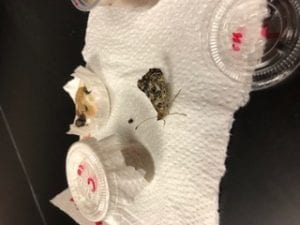For this butterfly lab, we isolated two painted lady butterfly larvae to represent primary consumers. The purpose of the experiment was to determine the efficiency by which the larvae could incorporate the food (in this case, representing primary producers) into their own biomass. We took two plastic cups. Both contained food medium. One only contained the food medium, and the other had the food medium as well as the butterfly larvae. We measured the mass of each cup every few days. Each day we calculated the daily mass loss of each cup. This helped to eventually calculate the mass of the butterfly chrysalises, which in turn allowed us to determine the efficiency by which the larvae incorporated the food medium into its own biomass. Our data led us to the conclusion that the butterfly larvae incorporated food medium into their own biomass with 24% efficiency. Typically, primary consumers can only incorporate food into biomass with 10% efficiency. We worked with an extremely small data sample, only having two larvae, so that could skew the results. Perhaps with a larger data sample, our results would have been more accurate. We are currently in the unit of chapters 51-55 in class. This lab relates to what we’ve been learning in class because it relates to ecology, which is the study of living things and their interactions with one another and their environment, as well as how organisms and their environments change over time.
Archives: September 2018
Fitness Testing
Included here is the link to my fitness testing data sheet.
https://docs.google.com/document/d/1C1SxUvyYoZnWbX3e7SdwPr5sjp4ewbIazT_chQqAwgU
directions to posting
-click new
-click post
-title it
-click add media (if any) to add videos or documents
-tag (for this class, PE 2018/19)
-add fairview advantage tags that apply
-post it
